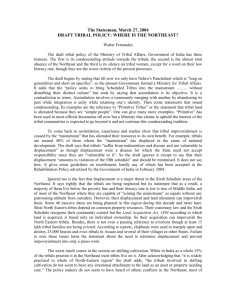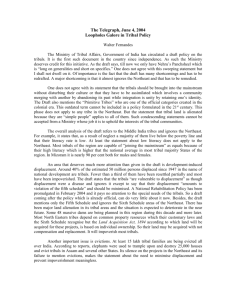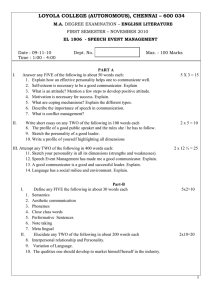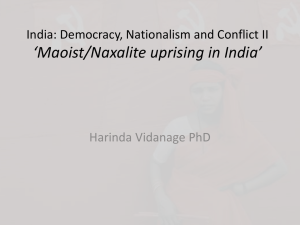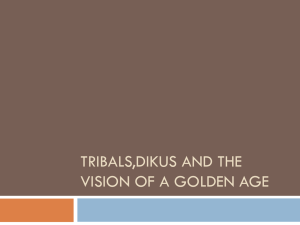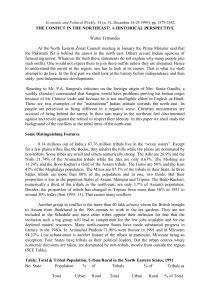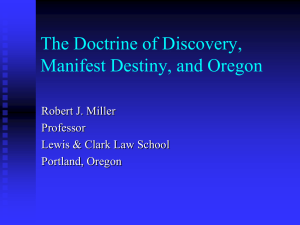Neo-liberalist Policies, Tribal Material and Non
advertisement
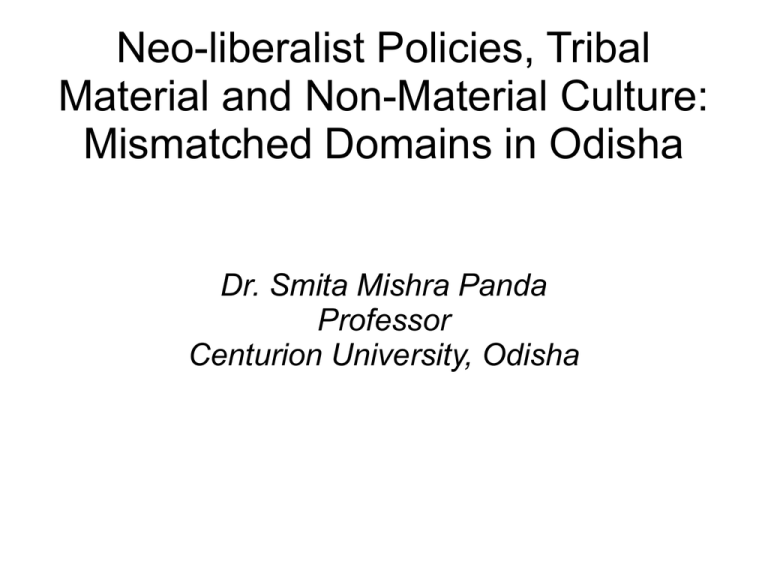
Neo-liberalist Policies, Tribal Material and Non-Material Culture: Mismatched Domains in Odisha Dr. Smita Mishra Panda Professor Centurion University, Odisha Plan of Presentation Introduction Neo-liberal Invasion and Tribals Violation of Cultural Rights Reactions from the Margins Is there an Alternative? Introduction Odisha - 62 tribal communities 23% of the population Concentrated in the northern and southern dists. One extreme are those living in extreme isolation and the other completely hinduised, converted to christians – not distinguishable from non-tribals Tribals have a distinct cultural identity – language, dress, ornaments, rituals, art, crafts, housing and festivals. Economic and political marginalisation 80% living under below poverty levels Neo-liberal Invasion Manifested in extraction based industrialisation – mining for bauxite, iron-ore and chromium Concentration of tribals, minerals and forests in the same space Post 90s Forests, mountains and water systems are taken over in large land grab projects by multinational companies backed by the state “Mining projects are fueled by an entrenched notion of development so powerful, that democracy and human rights often seem to wither in the face of it” (Padel and Das 2010: 10) Neo-liberal Invasion Nearly 1.5 million tribals have been displaced – includes environment, marginalisation, deprivation of life and livelihood and resource sustainability – is overlooked within the narrow paradigm of cost-benefit analysis in economic rationalisation. Transition of tribal development policy – from ‘needs’ based to ‘desires’ based approach – placed tribals in a situation of enduring poverty and marginalisation through consumer market mechanism Benefits of such an approach to development has not accrued to the tribals – live in poverty Insensitive mining that affects the cultural and ecological values of the tribals 1019 sq km has been leased for mining – illegal mining is rampant Unsustainable employment in the mining companies for tribals Violation of Cultural Rights Systematic violation of human rights -cultural rights of the tribals with no sign of reversal Much of the literature on the topic however concentrates on impact on livelihoods Culture – material and non-material is affected Recently in 2010 – Felix Padel and S. Das in their book 'Out of this Earth' have dealt with the impact on culture of Dongaria Khond tribals Used the term – “Cultural Genocide” - strong expression of development induced displacement and loss of cultural rights Violation of Cultural Rights Economic System Kinship System Religious System Material Culture Power Structure Example of – loss of swidden cultivation Among the Juang and Saora tribals of Odisha - Loss of multiple crops that they grew. - Harvesting of paddy, millets and pulses are done at different times from the same plot of land – closely embedded n their seasonal calendar and culture - Swidden cultivation plots have declined and so has the number crops that tribals grew in them Violation of Cultural Rights (Social Costs of Development) Social Cost Material/Non-material culture affected Displacement of villages and cultivated land Loss of traditional/customary practices – songs, calendar, rituals, folklore Breakdown of tribal social structure Cultural and family values – cohesiveness Degradation of environment – forests, water and land Loss of livelihood resource base and indigenous knowledge Conflict between those in favour and against the companies Solidarity among people of the same community affected Deterioration of older cooperation based values, availability of easy money Corruption of values – egalitarian relations affected Health dangers – respiratory, cancer etc. Loss of good health – inability to do hard work – e.g forest and swidden cultivation Proliferation of arms industry Primary of military war over valuing tribal culture and values (adapted from Padel and Das 2010) Reactions from the Margins In the form of struggles and resistances – Lanjigarh (Vedanta), Kalinganagar (Tata and others), Paradip (Dhinkia area – POSCO), Rayagada, Jharsuguda and many more Women seem to be more active in the movements Successful in creating a strong oppositional space for resistance Voices from the margins have got prominence e.g of Vedanta Reactions from the Margins - Growing left wing extremism in the tribal areas – 17 districts of Odisha affected - Non-cooperation with the govt and its programmes Niyamgiri Gram Sabha – Against Vedanta Company Protest against Vedanta Gram Sabha meeting with the local officials Is there an Alternative? Commercialisation of Tribal Art Is there an Alternative - Need to discuss alternatives to mainstream development thinking and practice, and how these alternatives may affect local and global processes of marginalisation and change the lives of tribal communities – academic level - In practice, the state needs to respect the cultural rights of tribals and protect them – keeping the constitution in mind - Need for some basic institutions of modernisation which can uphold indegenity and modernity together without much overlap.
